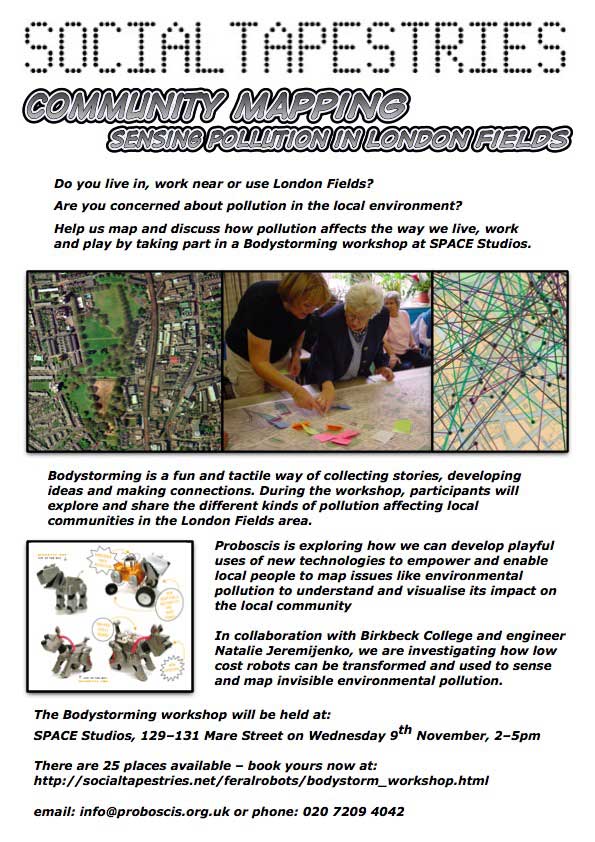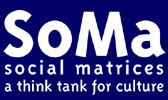
| outline | outcomes | documentation | software | background | credits | workshop |
 |
Robotic Feral Public Authoring What background environmental factors such as air quality, noise and light pollution affect our neighborhoods? How can we measure pollution in our own localities and make this data visible? How can we make sense of this in the context of what we already know about the places we live, work and play in? |
About
Robotic Feral Public Authoring links together two branches of research
for community fun and action. Hobbyist robotics and public authoring (knowledge
mapping and sharing) both enable people to use emerging technologies in
dynamic and exciting new ways. Brought together they open up whole vistas
of possibilities for exploring our local environments with electronic
sensors to detect all kinds of phenomena and map them using online tools.
Everyday
Archaeology
Electronic sensors are now cheaply available for detecting a wide range
of phenomena such as carbon monoxide, nitrogen dioxide, solvent vapours,
electro-magnetic emissions (mobile phone masts, electricity generators
etc), light and noise pollution. These can be combined with other cheap
electronics (such as toy robots) that engage people in evidence collecting
in a fun and tactile way.
Adding the sensor readings to online mapping tools, such as Urban Tapestries, suddenly brings the relationships between environment and home vividly to life. It enables people to feel they can learn about their environment and have the evidence to do something about it. By linking robot building and mapping workshops into traditional community events (village fetes and local festivals etc) a wide range of people can become involved in gathering and sharing knowledge about their environment.
- Public
Presentations and Events:
- Robot demonstration and talk by Giles Lane & Natalie Jeremijenko at the Takeaway Media Festival at the Science Museum's Dana Centre in London (part of the NODE.L season of media arts in London) on March 30th/31st
- Community mapping workshop with local participants near London Fields
- workshop documentation: DIFFUSION eBook
- Publications:
- Cultural Snapshot on Public Authoring and Feral Robotics (March 2006)
- Special fold out map publication (March 2006)
- Project Postcard [PDF 172Kb] (February 2006)
- Films:
- Project film [3 mins Quicktime Movie 8.1Mb] (March 2006)
- London Fields Robot Trial [1 min Quicktime Movie 2.4Mb] (March 2006)
- Prototypes:
- construction and testing of prototype robot uploading sensor data to Urban Tapestries:
- Feral Robot Design & Construction (January 2006)
- Initial Field Trial in London Fields (January 2006)
- [Initial] Sensor Readings Visualisation (February 2006)
- Sensor Readings on Urban Tapestries (forthcoming April 2006)
- Technical Documentation and Software available as open source resources:
- Technical Documentation (February 2006) [PDF Version]
- Feral Robots Software for Gumstix platform (February 2006)
Background
For this project Proboscis and Natalie Jeremijenko collaborated to jointly
explore intersections between their current work, specifically Proboscis'
Urban Tapestries platform and Natalie Jeremijenko's Feral Robots. Natalie
Jeremijenko's experimental robotics projects reconfigure low cost robots
that are sold as consumer toys into vehicles of social and cultural activism.
Her workshops have explored the possibilities of robotics breaking out
of the academic lab and using the economies of scale of consumer manufacturers
to put sophisticated equipment into the hands of the general public. Her
project has developed a series of kits which adapt the toy robots into
powerful sensing devices for locating and identifying chemical pollution
and radiation.
Combining these two modes of social and cultural exploration will form the basis of the Visiting Fellowship: aiming to leverage the practical, hands-on approach of 'hobbyist' robotics with the ability to annotate specific geo-locations. Our aim is to design and create practical applications of such 'creative misuse' of commercially available technologies for social and cultural public benefit.
This research project intended to:
- explore and share innovative transdisciplinary research, development and creative dissemination models between engineering and creative arts practice.
- investigate the potential for integrating experimental robotics with emerging mobile and pervasive systems for public authoring and to develop experimental communication prototcols.
- demonstrate how low cost robotics can achieve technical efficiences and have consequences beyond entertainment and academia.
- produce documentation (films/website/print materials) of the collaborative process and outcomes to engage a wider public audience in the social and cultural issues.
- develop a prototype experimental robot able to annotate geographic space with sensor readings using the Urban Tapestries system.
- create experiences based on the research for the public, which aim to inspire and influence not only audiences but peers in academia, the arts, civil society and industry.
The Fellowship aimed to bridge the experimental robotics field with that of pervasive location based public authoring. The collaboration is intended to investigate the possibilities for artists and engineers to develop compelling new forms of social and cultural intervention that can be adopted and adapted by ordinary people, using the tools and materials available to them. Its objectives are:
- to investigate social and cultural contexts for bridging robotics with pervasive and location based technologies.
- to develop a prototype experimental robot able to annotate geographic space with sensor readings via the Urban Tapestries authoring platform.
- to share innovative research methodologies and creative dissemination techniques between design engineering and the arts.
- to create experiences based on the research for the public, which aim to inspire
The research is intended to address the following questions:
- how can ordinary people adopt and adapt consumer technologies to do more than entertain them – to intervene socially and culturally in their environment?
- what kinds of social and cultural issues can be explored through this combination of experimental robotics and pervasive location-based public authoring?
- how can artists and engineers inspire and influence the roll-out of emerging technologies by manufacturers and network providers as enabling tools for users, not just modes of consumption?
- how might perceptions of place and space be altered by these new public abilities of collaborative mapping and annotation?
| Principal Investigator | Giles Lane |
| EPSRC Visiting Fellow | Natalie Jeremijenko |
| Proboscis Team | Alice Angus, Camilla Brueton, Karen Martin, Sarah Thelwall & Orlagh Woods |
| Partners |
Birkbeck
College Computer Science Dept Dr George Roussos, Dimitri Airantzis, Dima Diall, Dikaios Papadogkonas & George Papamarkos |
| Space
Media Arts Peter Chuancy & Gini Simpson |
|
| Funding | EPSRC Culture & Creativity Programme |

©
2004-2006 Proboscis. Some
Rights Reserved Last updated October 25, 2006 | sitemap | Join Mailing List |

